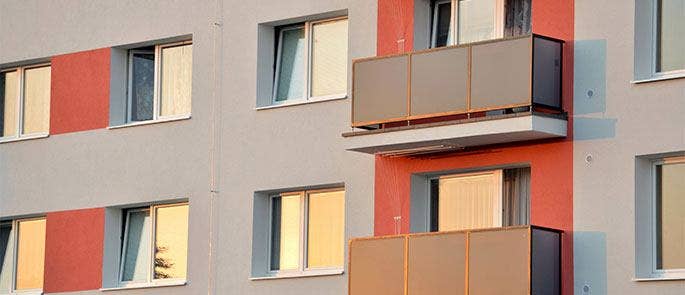What is the Building Safety Act (BSA)?
The Building Safety Act 2022 (BSA) is a recent change to building regulations that aims to put occupant and resident safety at the forefront of all new building developments and at all points of the design, construction and maintenance processes. In this article, we’ll explain what the Building Safety Act is and who it applies to, give a timeline of events related to the new Act and highlight key points of the Building Safety Act that everyone in the industry needs to be aware of.
What is the Building Safety Act?
The Building Safety Act 2022, which came into force in October 2023, is a new regulation that aims to put the safety of building occupants at the forefront of the building process. All aspects of the building process are covered by the Act, from building design to construction and management, to ensure residents and homeowners are safer, have more rights and live in higher-quality homes. It also holds those responsible for safety defects to account.

The introduction of the Building Safety Act (BSA) is a direct result of the catastrophic Grenfell Tower fire that occurred in London in June 2017. Following the incident, an inquiry into the construction industry was conducted and it was determined that more safety procedures were desperately needed. The recommendations from the Grenfell inquiry led to the formation of the Building Safety Act.
The BSA has also created three new bodies to oversee the new regulations:
- The Building Safety Regulator (BSR) is responsible for overseeing the safety and performance of all buildings, with a focus on high-rise buildings like that of Grenfell.
- The National Construction Products Regulator (NRCP) is responsible for leading surveillance and enforcement across the UK’s construction products market.
- The New Homes Ombudsman Scheme is a more efficient way for owners of new-build homes to escalate their complaints to building developers.
What Buildings Does the Building Safety Act Apply To?
The Building Safety Act applies across the whole construction process and so affects everyone in this industry, from architects and developers to engineers, tradespeople, facilities managers and housing management companies.
Currently, the Building Safety Act applies to residential Higher-Risk Buildings but is likely to be expanded in the future to include all buildings. Higher-risk buildings are those with at least two residential dwellings and/or over 18 metres or seven storeys high. It also includes buildings like hospitals and care homes where people reside.
The BSA gives extra rights and protection for residents of high-rise buildings – like Grenfell Tower – as these are one of the most high-risk types of dwellings. High-rise residents are now able to have more say on how their building is kept safe and can raise safety concerns directly to the person in charge of the building, who must listen to them by law.

The person or people in charge of building safety, whether that’s the building owner, a management company or a freeholder, is known under the BSA as the Accountable Person. If there’s more than one person responsible, then there must be a nominated Principal Accountable Person.
By law, the Accountable Person has a duty to:
- Continually assess building safety risks.
- Demonstrate how they are actively ensuring resident safety.
- Listen to residents’ safety concerns.
- Create a Building Safety Case Report that outlines how safety risks are being identified, mitigated and managed.
- Digitally record all decisions, updates and actions taken in relation to the building’s safety via a Golden Thread of Information.
Are you the Accountable Person for a residential building?
Whether you’re a building owner, facilities manager, landlord or developer, our range of Online Health and Safety Courses contains essential information on the health and safety legislation you need to know in order to keep residents safe from harm.
Building Safety Act 2022 Summary of Key Facts
Below is a summary of the key information contained within the Building Safety Act to help you understand more about your rights and responsibilities:
- During construction, building owners and dutyholders must manage the building’s safety risks and ensure clear lines of responsibility at all stages, from design to construction and completion.
- Those who are designing and constructing higher-risk buildings now have a legal responsibility for complying with building regulations and reducing safety risks.
- Organisations that own and manage high-rise residential buildings must identify risks, put measures in place to keep residents safe and keep evidence of their actions.
- The new ‘gateway’ system means that building work cannot begin until the Building Safety Regulator has approved the application.
- Upon completion, new buildings will be assessed for compliance with the law by the BSR and issued a Building Assessment Certificate that permits the building to be occupied.
- Building owners/managers are required to keep up-to-date safety information about their buildings, including information about how it was designed and built and how it’s being managed to keep people safe, both now and in the future. This requirement for an auditable trail of accountability is known as the Golden Thread of Information and it is stored digitally for the entire life of the building.
- Building owners and landlords must contribute to the costs of fixing their own buildings. They cannot charge leaseholders for any costs related to historical safety defects, like cladding removal.
- A new building safety charge for leaseholders ensures residents know exactly what they are being charged for. The cost of these charges is limited by law.
- All homeowners now have 15 years in which to claim compensation for any substandard construction work on their home.
- The BSA also introduced amendments to the Regulatory Reform (Fire Safety) Order 2005. The changes include more cooperation between responsible persons, better recording of fire safety information and clearer enforcement of the law for instances of non-compliance.
Building Safety Act Timeline of Development
The Building Safety Act timeline began in 2017 and ends with the present day. A few key dates are as follows:
- June 2017 – the Grenfell Tower fire led to 72 deaths and was claimed to be the UK’s worst residential building fire since World War 2.
- September 2017 – the first stage of the Grenfell Tower Inquiry revealed that the cladding on the building’s exterior did not comply with safety regulations and was the main reason why the fire spread so quickly.
- May 2018 – the final report of Dame Judith Hackitts’ independent review into building regulations and fire safety was published, outlining a number of key failings and recommendations.
- July 2021 – the Building Safety Bill, which set out a clear pathway for how residential buildings should be constructed and maintained, was introduced to Parliament.
- April 2022 – the Building Safety Act received Royal Assent and became an Act of Parliament.
- October 2023 – the main requirements of the Building Safety Act came into force and all building owners were required to register with the Building Safety Regulator.
- December 2023 – the BSR released an enforcement policy statement, outlining their enforcement methods for breaches of the law.
- January 2024 – the UK Government released information on the mandatory process for notifying the BSR of any safety occurrences within residential buildings.
- April 2024 – the BSR’s new building safety regime began and Building Assessment Certificates started to be issued to new constructions.

The Building Safety Act 2022 is an important new piece of health and safety legislation that everyone involved in the design, construction and management of residential buildings must comply with. The safety of residents – particularly in higher-risk buildings – should be the number one priority for all new-builds and dutyholders must take steps, keep accurate records and actively maintain their buildings to ensure residents are kept safe at all times.
Further Resources:
- Online Health and Safety Courses
- What are Safe Systems of Work?
- ISO 31000 – Risk Management
- Quality Assurance in Construction
- Facilities Management Online Training







